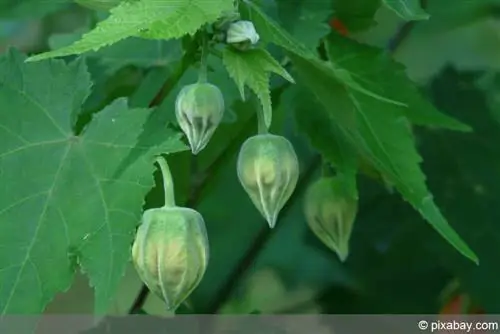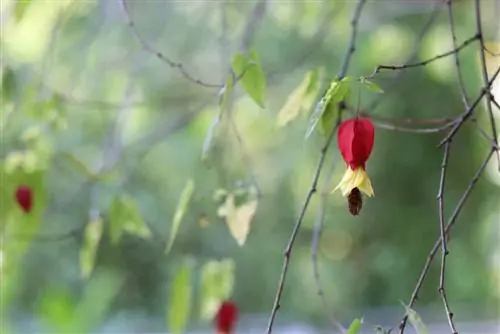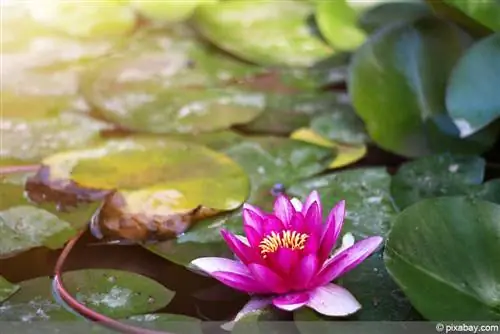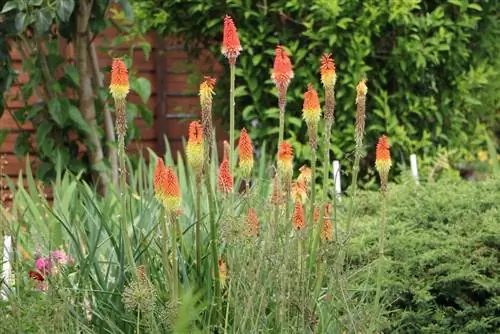- Author admin [email protected].
- Public 2023-12-17 03:39.
- Last modified 2025-01-24 12:45.
The beautiful mallow Abutilon megapotamicum is a half-climbing and half-shrub species that is also known as indoor maple and velvet poplar. The upright growing shrubs form overhanging shoots. What is special about this plant are its flowers. Bright yellow corollas with a brown pistil protrude from a fiery red, balloon-like calyx. When cultivated in a pot, for example on a balcony or terrace, this beautiful mallow can reach heights of up to 150 cm. Wintering should definitely be frost-free.
Location and soil
What all species have in common is the requirement for a warm and sunny to partially shaded location without direct sun. A few hours of sun in the morning and evening is ideal. Sufficient shade must be provided in a sunny window seat. She can go outside from mid/late May until autumn. It should be placed outside in a place protected from wind and rain and protected from the blazing midday sun. The delicate shoots of the beautiful mallow are relatively sensitive and could be damaged if left unprotected. This plant thrives best at temperatures between 19 and 21 degrees, and correspondingly cooler in winter. The substrate should have a pH between 6.0 and 6.8. It can be a compost-based potting soil that is permeable and has the highest possible humus content. Not to forget a drainage layer to protect against waterlogging.
Tip:
If the beautiful mallow loses leaves, this can be due to strong temperature fluctuations, a location that is too dark and draughty, or even a change of location.
Watering and fertilizing
From spring to autumn, water should be abundant and regular without causing waterlogging. The substrate should always be evenly moist and the root ball should never dry out completely; the beautiful mallow would react to this by dropping its leaves. Before each watering, allow the top layer of substrate to dry slightly. Excess water in the saucer or planter must be removed regularly. Fertilization should also be carried out regularly, once every 2 weeks from April to August/September. Suitable for this include: commercially available liquid fertilizer, flowering plant fertilizer or fertilizer sticks for flowering plants.
Cut
- The beautiful mallow tends to become bald and grow sparsely over the years.
- That's why regular pruning is recommended.
- This can be done in early spring or directly after flowering.
- The beautiful mallow can also tolerate severe pruning, up to half or down to the old wood.
- Additionally cut out any unsightly or annoying or wilted shoots.
- If the right cutting time has been missed, it can be cut in autumn.
- In this case, cut before putting away for winter quarters.
Tip:
So that the plants remain compact and do not become bald, young plants can be trimmed several times a year.
Wintering

Beautiful mallows are generally not hardy and require frost-free overwintering in a bright room at temperatures between 10 and 12 degrees. The room temperature should not rise above 15 degrees. In winter, watering is much more sparing; the cooler the overwintering, the less watering. The bale should not dry out completely even in winter. Fertilizer is now completely dispensed with. Before you put the plants outside again in spring, you should harden them off to avoid sun burns. It is best to place them in a semi-shady place for the first 1-2 weeks. After these 2 weeks, the beautiful mallow can then be placed in its final place.
Tip:
Severe temperature fluctuations should be avoided, they can lead to leaf and flower drop.
Repotting
- If the pot is heavily rooted, repot Abutilon megapotamicum.
- The best time for this is in March.
- First take the plant out of the pot and remove the old soil.
- Also cut off dead root parts.
- The new planter should be only slightly larger than the old one.
- Drain holes and drainage layer essential so that excess water can drain away.
- Immediately after planting, shorten the mallow by about a third.
- This results in better branching.
After repotting, the plant should not be exposed to direct sun for the first 2-3 weeks. Older specimens may need to be repotted annually.
Propagation
Head cuttings
The simplest and most effective form of propagation is via head cuttings. These are cut in spring; they should be around 8-12 cm long. The lowest leaves are removed and large ones shortened if necessary to keep evaporation as low as possible. Then you place one or more cuttings in the growing substrate, moisten it and put a translucent film over it for the first 3-4 weeks. The soil temperature should be around 22 degrees. To avoid rot and mold formation, the film must be removed from time to time and the whole thing must be ventilated. The cultivation container is placed in a warm and bright but not sunny place. Abutilon megapotamicum requires ambient temperatures of 19-22 degrees for root formation. After rooting has taken place, which can be recognized by new shoots, the young plants can be planted in the garden.
Tip:
A suitable growing substrate can be found e.g. B. make your own from equal parts sand and peat.
Sowing

When sowing, the seeds should only be lightly covered with soil because they germinate in light. It is best to use an indoor greenhouse. Place the seeds in sowing soil, press them lightly and moisten the substrate. Until germination, it should always be slightly moist and not dry out at any time. To avoid mold or rot, remove the cover briefly and often. Under optimal conditions, the seeds germinate within 2-3 weeks.
Tip:
If you use seeds from your own harvest, it may happen that the new plants have different properties than the mother plants. This is the case if the mother plants are hybrids.
Potential pests
Whitefly
Infestations often occur when the air in the room is too dry. It is shown by the leaves turning yellow, drying up and falling off and of course by small whiteflies on the plant. The number of adult animals can be reduced using yellow boards or yellow stickers. To combat the larvae, systemic preparations from specialist retailers are available. The natural predators include parasitic wasps and chalcid wasps, which can be purchased from beneficial insect mail order companies. As a preventive measure, attention should be paid to optimal location conditions and care.
Aphids
Aphids mainly attack young shoots and flower buds. Stunted shoot tips and stunted flowers can indicate an infestation, as can sticky honeydew on leaves. If there is an infestation, you can shower the plant thoroughly, not forgetting the undersides of the leaves. Beforehand, put the entire pot in a plastic bag that you close at the top so that no lice can fall onto the substrate. If there is a severe infestation, chemical products from specialist retailers can help. To avoid chemicals, you can also use natural predators such as: E.g. lacewings, gall midges or ladybirds.
Spider mites
A spider mite infestation can be seen in fine white webs, especially in the leaf axils. Spraying with plant decoctions or suitable neem oil products helps against this. Beneficial insects such as lacewings, predatory bugs, gall midges, parasitic wasps or ladybirds can also be used here.
Tip:
No matter which pests the plants are infected with, they should always be isolated from he althy plants immediately to prevent infection or spread.
Conclusion
The hanging mallow can grow quite luxuriantly and become relatively large under optimal conditions. The attractive flowers make the plant an eye-catcher all summer long. The care is quite undemanding, only frequent changes of location, locations that are too dark and strong fluctuations in temperature should be avoided.






